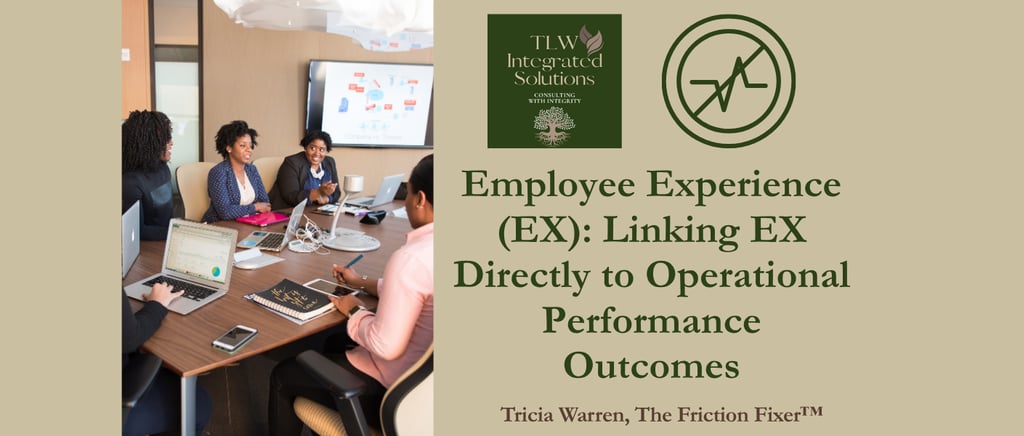Employee Experience (EX): Linking EX Directly to Operational Performance Outcomes


In today’s rapidly evolving business landscape, we often hear leaders talk about employee engagement. While engagement is critical, there’s an even deeper lever for operational success: Employee Experience (EX). EX encompasses every touchpoint an employee has with your organization—from onboarding and daily interactions to career growth and even exit experiences.
Throughout my work, I’ve observed firsthand how organizations that prioritize EX achieve significant operational improvements, particularly during times of substantial change. When employees feel supported, connected, and valued, they not only adapt more quickly—they actively drive operational performance.
Real Impacts
Let me share a quick story from a transformation I supported for a midsized technology company product and services team. The leadership team was frustrated by stagnating productivity, increased turnover, and resistance to new technology initiatives. When we dug deeper, the core issue became clear: the employee experience was fragmented, inconsistent, and left teams feeling undervalued & uninformed during times of change.
We took immediate, strategic steps to enhance EX:
Implemented structured change management practices, ensuring transparent and consistent communication.
Introduced regular listening sessions to actively solicit employee feedback and address concerns in real time.
Created tailored training and career development opportunities via a perfromance management framework, aligning employee growth with the organizational direction.
Within just six months, these targeted EX improvements resulted in a noticeable turnaround: productivity rose by approximately 20–25%, voluntary turnover dropped by around 15–18%, and employee satisfaction scores improved by just over 30%, based on internal survey data and team performance metrics.
A Personal Reflection
On the flip side, I’ve experienced what it feels like when employee experience is treated as an afterthought.
I once joined a company as a senior member of the leadership team, full of enthusiasm and ready to make an impact. But from day one, I felt like a stranger. Outside of a couple of emails, I had almost no engagement with leadership during my first month. There was no structured onboarding, no clarity on how my role would be introduced or integrated, and no strategy for how I was expected to contribute. My day-to-day became a cycle of trying to “figure it out,” rather than feeling empowered to lead.
I share this not to call out a company or cast blame, but to underscore a hard truth: you can’t expect performance and loyalty from people who feel invisible. That experience is one of the key reasons I now advocate so strongly for EX as a strategic, operational priority. Because how we welcome, support, and empower people shapes not only their performance—but the entire trajectory of your business outcomes.
Data-Driven Insights & Strategies to Improve EX
A 2024 study by Gallup reveals that organizations with superior employee experience practices achieve:
21% higher profitability
17% higher productivity
24% lower turnover
Further supporting this, Deloitte’s Global Human Capital Trends (2024) emphasizes that companies effectively linking EX to operational outcomes are twice as likely to navigate organizational change successfully.
Four Strategies to Improve EX and Drive Operational Performance
Linking EX directly to performance isn’t accidental—it requires intentional strategies. Here are four actionable approaches you can implement:
Embed EX in Change Management Initiatives: During times of change, clearly articulate how transitions impact and benefit employees. Keep communication transparent, consistent, and two-way.
Prioritize Career Growth and Development: Show a real commitment to helping people grow. Employees who see a future with you are more resilient and aligned with long-term goals.
Foster an Inclusive and Empowering Culture: Employees should feel heard and valued. Inclusive cultures drive innovation, faster adaptation, and greater loyalty.
Continuously Measure and Adapt: Use pulse surveys and real-time feedback tools to assess EX. Adapt based on what employees need—don’t wait until the next crisis.
The Leadership Imperative
Leadership commitment is essential for integrating EX into your operational strategy. According to McKinsey (2024), organizations with senior leaders who actively champion EX initiatives see performance improvements 40% faster than those without such involvement.
When leaders show that people matter, it sets the tone for the entire organization. Not just in words—but in actions.
EX isn’t just an HR initiative. It’s a powerful operational lever that drives measurable performance gains. A well-designed, intentionally supported employee experience fuels innovation, efficiency, and resilience at every level of your business.
How is your organization linking employee experience to performance outcomes? What’s worked—and what’s been tough? Drop a comment or DM me—I’d love to learn how you’re elevating EX in your business.
